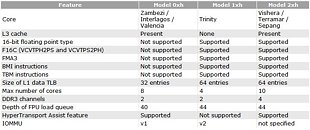- Joined
- Oct 9, 2007
- Messages
- 47,244 (7.54/day)
- Location
- Hyderabad, India
| System Name | RBMK-1000 |
|---|---|
| Processor | AMD Ryzen 7 5700G |
| Motherboard | ASUS ROG Strix B450-E Gaming |
| Cooling | DeepCool Gammax L240 V2 |
| Memory | 2x 8GB G.Skill Sniper X |
| Video Card(s) | Palit GeForce RTX 2080 SUPER GameRock |
| Storage | Western Digital Black NVMe 512GB |
| Display(s) | BenQ 1440p 60 Hz 27-inch |
| Case | Corsair Carbide 100R |
| Audio Device(s) | ASUS SupremeFX S1220A |
| Power Supply | Cooler Master MWE Gold 650W |
| Mouse | ASUS ROG Strix Impact |
| Keyboard | Gamdias Hermes E2 |
| Software | Windows 11 Pro |
AMD might be a little sore that its "Zambezi" FX processor family based on its much-hyped "Bulldozer" architecture didn't quite meet the performance expectations of a ground-up new CPU architecture, but it doesn't want to take chances and build hype around the architecture that succeeds it. From various sources, some faintly-reliable, we have been hearing that the next-generation of high-performance desktop processors based on "Piledriver" architecture, codenamed "Vishera", will pack five modules or 10 cores, and will be structured essentially like Zambezi, since Piledriver is basically a refinement of Bulldozer architecture. The latest leak comes from the Software Optimization Guide for AMD 15h family (read here), which was picked up by CPU World while most of us were busy with CES.
CPU World compiled most of the features of what it suspected to be AMD referring to its future processors based on the Piledriver architecture, that's "Vishera" (desktop high-performance), "Terramar" (high-density server), and "Sepang" (small-medium business server) parts. The three are not the first chips to be based on Piledriver, AMD has a new mainstream desktop and notebook APU in the works codenamed "Trinity", which is en route for a little later this year. Trinity basically has an identical CPUID instruction-set as Vishera, Terramar, and Sepang, confirming their common lineage compared to today's "Bulldozer" architecture. The most catchy detail is of Vishera featuring 4 DDR3 channels.

The plot thickens where "HyperTransport Assist feature" is listed as being supported on Vishera. HT Assist is a feature found on AMD's enterprise socket G34 processors, which facilitates better inter-die communication between the two dies of a typical socket G34 Opteron processor. The G34 (LGA1972) package is a multi-chip module of two quad-core, six-core, or four-module dies, which combined have four DDR3 memory channels, and a number of HyperTransport links to communicate with neighbouring sockets and the system's chipset. Could this be the first indication that AMD wants to take on Intel LGA2011 HEDT (high-end desktop) using Vishera chips in the G34 package? It will be a while before we find out.
Apart from using common silicon between client and enterprise platforms, AMD does have a history of colliding the two.
View at TechPowerUp Main Site
CPU World compiled most of the features of what it suspected to be AMD referring to its future processors based on the Piledriver architecture, that's "Vishera" (desktop high-performance), "Terramar" (high-density server), and "Sepang" (small-medium business server) parts. The three are not the first chips to be based on Piledriver, AMD has a new mainstream desktop and notebook APU in the works codenamed "Trinity", which is en route for a little later this year. Trinity basically has an identical CPUID instruction-set as Vishera, Terramar, and Sepang, confirming their common lineage compared to today's "Bulldozer" architecture. The most catchy detail is of Vishera featuring 4 DDR3 channels.

The plot thickens where "HyperTransport Assist feature" is listed as being supported on Vishera. HT Assist is a feature found on AMD's enterprise socket G34 processors, which facilitates better inter-die communication between the two dies of a typical socket G34 Opteron processor. The G34 (LGA1972) package is a multi-chip module of two quad-core, six-core, or four-module dies, which combined have four DDR3 memory channels, and a number of HyperTransport links to communicate with neighbouring sockets and the system's chipset. Could this be the first indication that AMD wants to take on Intel LGA2011 HEDT (high-end desktop) using Vishera chips in the G34 package? It will be a while before we find out.
Apart from using common silicon between client and enterprise platforms, AMD does have a history of colliding the two.
View at TechPowerUp Main Site





